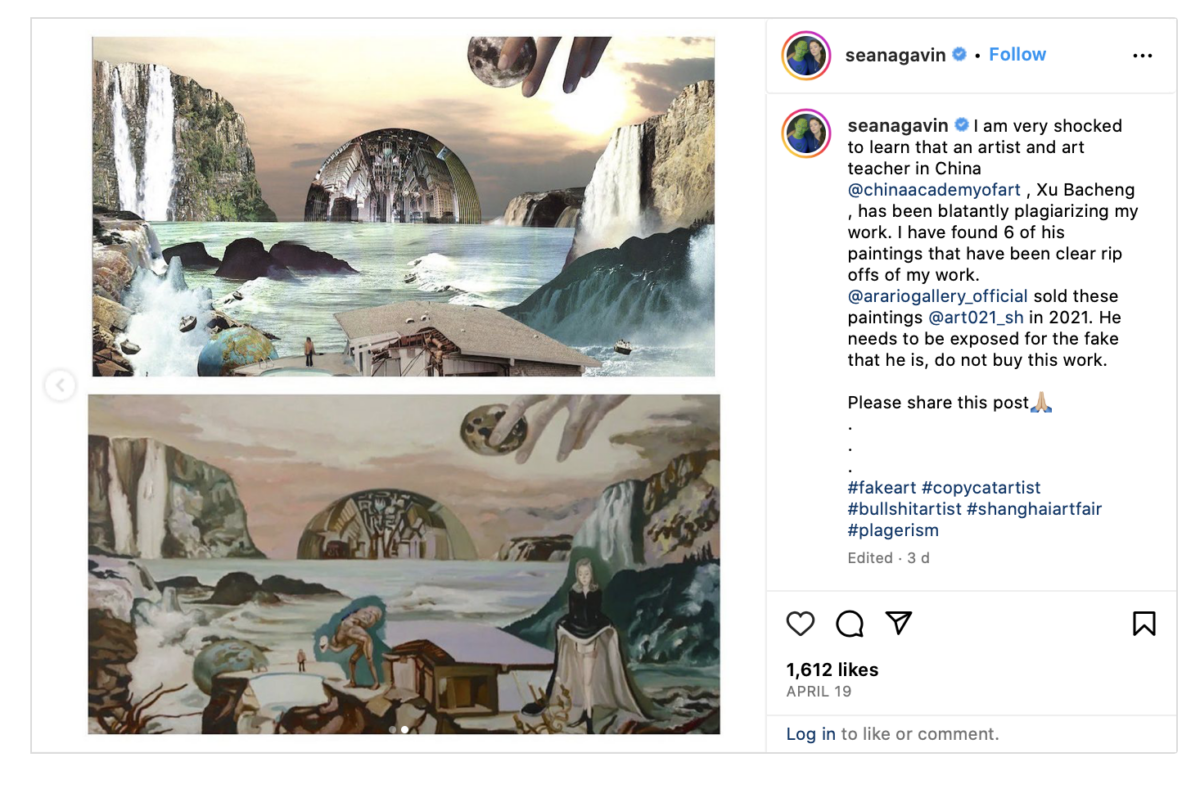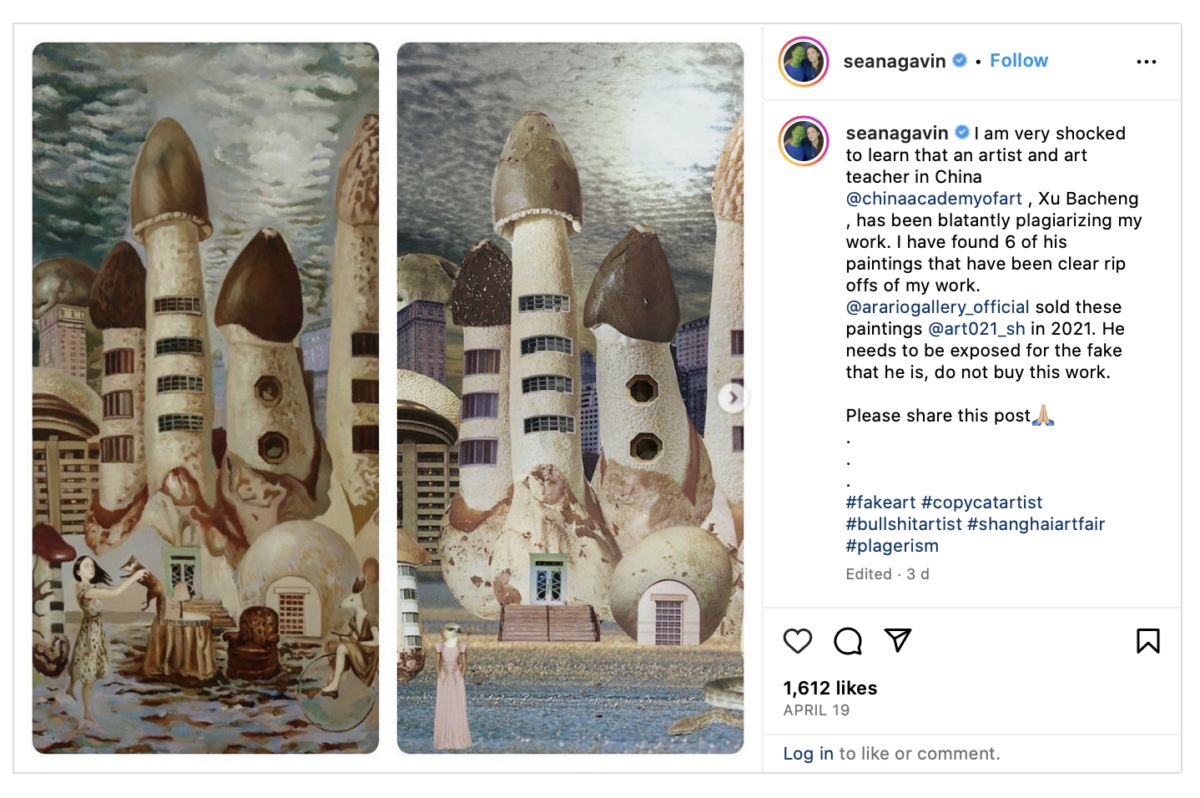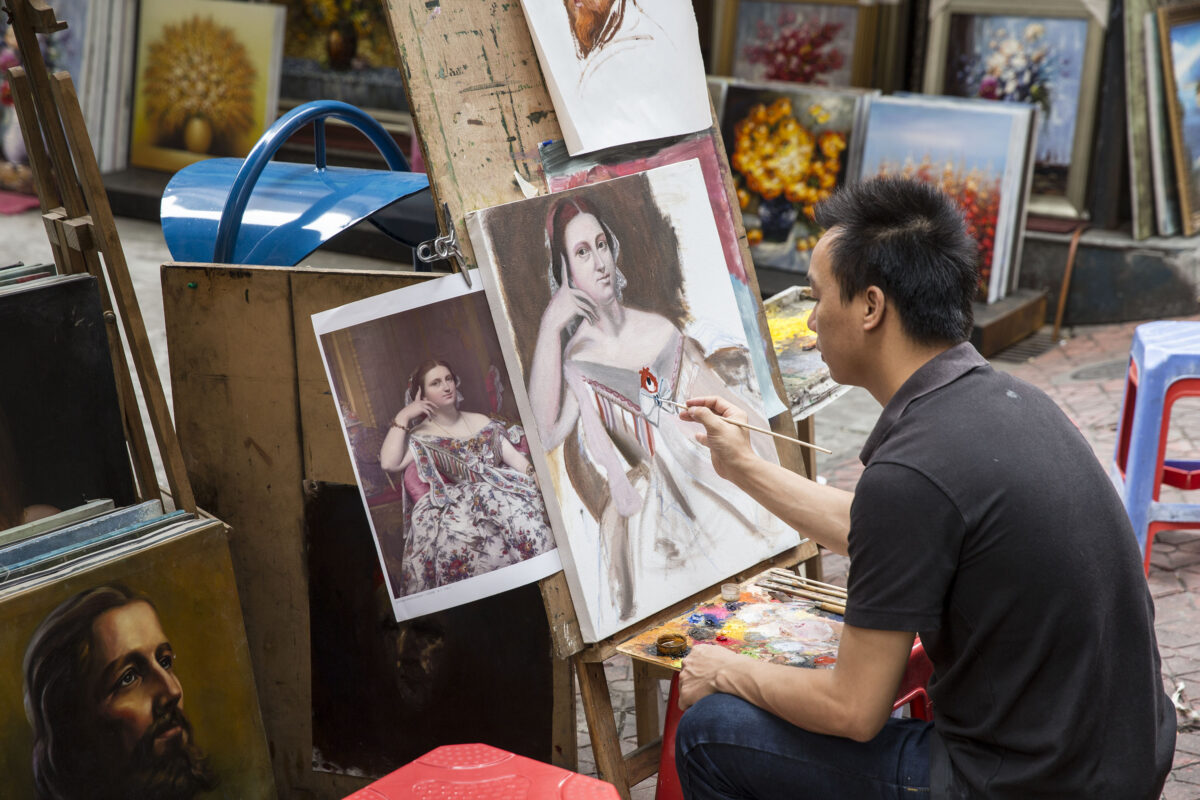Plagiarism Allegations Tarnish China’s Art Scene
Expert says a lack of legal sanctions contributes to the prevalence of plagiarism in China A British artist recently accused a Chinese painter at the China Academy of Arts of plagiarizing several of her works, raising concerns over the proliferation of plagiarism in the Chinese art field in recent years. British artist Seana Gavin’s April 30 Instagram post showed a drawing of Chinese painter Xu Bacheng that closely resembled Gavin’s work. (seanagavin/Instagram) On April 30, Seana Gavin, a London-based artist, posted on Instagram thanking her Chinese fans for their concern about plagiarism by Xu Bacheng, a teacher in the oil painting department at the China Academy of Arts. “Some of the allegations against him [Xu Bacheng] go back a decade,” she wrote, attaching her own paintings as well as Xu’s, so viewers could see the resemblance. British artist Seana Gavin’s April 19 Instagram post showed a drawing by Chinese painter Xu Bacheng that closely resembled her own work. (seanagavin/Instagram) Six of Xu Bacheng’s paintings are “clear rip-offs of my work,” said Gavin in a post of April 19, expressing her shock after learning the Chinese teacher “has been blatantly plagiarizing.” Gavin told her 10,200 followers on Instagram, “He [Xu Bacheng] needs to be exposed for the fake that he is, do not buy this work.” The China Academy of Arts has terminated employment with Xu Bacheng for his “academic misconduct,” according to an April 26 notice issued by the Hangzhou-based prestigious institute on Weibo, after Gavin’s post attracted widespread attention online. Xu Bacheng’s case is not alone. It is one of several sensational plagiarism cases that have occurred in the Chinese art world in recent years. Japanese commentator Ji Lin told The Epoch Times that it is no coincidence that plagiarism is rampant in China. It stems partly from China’s extreme communist ideology, Lin said, in which money becomes the driving force. “Chinese society has become money-oriented under the rule of the Chinese Communist Party (CCP),” she said. As a result, everything is treated with “haste, short-sightedness, and impetuousness.” Blatant Plagiarism A 2016 China Daily article reported that Chen Yunquan, a professor of Chinese painting at the Hubei Institute of Fine Arts, had discovered that a dozen line drawings in a prominent national exhibition were copies of his earlier paintings. The plagiarized works were signed by Wenzhou-born painter Guo Yuan. In addition, 71 drawings in an album published by Guo in November of 2012 were pirated from an earlier collection of Chinese bird-and-flower line drawers by Chen. Even the foreword to the album was virtually identical to Chen’s original. The copycat album was published under a formal publishing book number by a national publishing house. Chen told Chinese news media in 2016 that Sichuan Fine Arts Publishing House, the publishing house responsible for publishing Guo’s album, could have easily discerned the plagiarism because his books had been published several times, so editors at professional publishers should easily spot it. Not only was Guo’s album of plagiarized paintings published but in December of 2012, an exhibition of the drawings in the album was held in Guo’s hometown. “[Artists] in the Chinese art environment are too eager for quick success and profit and have no respect for academia,” Chen sighed, pointing to Guo’s copyright infringements. International Award-Winning Works Found to Be Pirated An artist working on his painting outside a gallery at the artist village on June 12, 2014 in Shenzhen, China. (Palani Mohan/Getty images) In October 2017, two works of Fan Yu, an associate professor at Xi’an Academy of Fine Arts, were selected for the Red Dot Award, a German international design prize considered to be the Oscars of the design field. One of the works won the prize’s highest honor. However, six months later, it was revealed that Fan’s winning works were plagiarized from two works created by British illustrator Russell Cobb in 2011, according to a report by Chinese state media The Paper. After confirming the facts, the organizers of the Red Dot Award immediately withdrew the honor previously awarded to Fan. Red Dot officials told the media that Fan had violated Cobb’s intellectual property rights as Fan had not claimed Cobb as the author and copyright owner of the images when he entered the competition. In China, “Art plagiarism, technical plagiarism, thesis plagiarism, knowingly breaking the law—showcases a whole society without a moral bottom line,” Zhuge Mingyang, an independent writer, told The Epoch Times on April 28, adding that the totalitarian rule of the CCP deprives people of inner moral direction. The Challenges of Defending Copyrights in China A man walks past artworks by the Sichuan Fine Arts Institute at China’s National Art Museum, in Beijing on June 15, 2017. (Wang Zhao/AFP via Getty Images) In 2019, Belgian artist Christian Si

Expert says a lack of legal sanctions contributes to the prevalence of plagiarism in China
A British artist recently accused a Chinese painter at the China Academy of Arts of plagiarizing several of her works, raising concerns over the proliferation of plagiarism in the Chinese art field in recent years.

On April 30, Seana Gavin, a London-based artist, posted on Instagram thanking her Chinese fans for their concern about plagiarism by Xu Bacheng, a teacher in the oil painting department at the China Academy of Arts.
“Some of the allegations against him [Xu Bacheng] go back a decade,” she wrote, attaching her own paintings as well as Xu’s, so viewers could see the resemblance.

Six of Xu Bacheng’s paintings are “clear rip-offs of my work,” said Gavin in a post of April 19, expressing her shock after learning the Chinese teacher “has been blatantly plagiarizing.” Gavin told her 10,200 followers on Instagram, “He [Xu Bacheng] needs to be exposed for the fake that he is, do not buy this work.”
The China Academy of Arts has terminated employment with Xu Bacheng for his “academic misconduct,” according to an April 26 notice issued by the Hangzhou-based prestigious institute on Weibo, after Gavin’s post attracted widespread attention online.
Xu Bacheng’s case is not alone. It is one of several sensational plagiarism cases that have occurred in the Chinese art world in recent years.
Japanese commentator Ji Lin told The Epoch Times that it is no coincidence that plagiarism is rampant in China. It stems partly from China’s extreme communist ideology, Lin said, in which money becomes the driving force. “Chinese society has become money-oriented under the rule of the Chinese Communist Party (CCP),” she said. As a result, everything is treated with “haste, short-sightedness, and impetuousness.”
Blatant Plagiarism
A 2016 China Daily article reported that Chen Yunquan, a professor of Chinese painting at the Hubei Institute of Fine Arts, had discovered that a dozen line drawings in a prominent national exhibition were copies of his earlier paintings. The plagiarized works were signed by Wenzhou-born painter Guo Yuan.
In addition, 71 drawings in an album published by Guo in November of 2012 were pirated from an earlier collection of Chinese bird-and-flower line drawers by Chen. Even the foreword to the album was virtually identical to Chen’s original.
The copycat album was published under a formal publishing book number by a national publishing house.
Chen told Chinese news media in 2016 that Sichuan Fine Arts Publishing House, the publishing house responsible for publishing Guo’s album, could have easily discerned the plagiarism because his books had been published several times, so editors at professional publishers should easily spot it.
Not only was Guo’s album of plagiarized paintings published but in December of 2012, an exhibition of the drawings in the album was held in Guo’s hometown.
“[Artists] in the Chinese art environment are too eager for quick success and profit and have no respect for academia,” Chen sighed, pointing to Guo’s copyright infringements.
International Award-Winning Works Found to Be Pirated

In October 2017, two works of Fan Yu, an associate professor at Xi’an Academy of Fine Arts, were selected for the Red Dot Award, a German international design prize considered to be the Oscars of the design field. One of the works won the prize’s highest honor.
However, six months later, it was revealed that Fan’s winning works were plagiarized from two works created by British illustrator Russell Cobb in 2011, according to a report by Chinese state media The Paper.
After confirming the facts, the organizers of the Red Dot Award immediately withdrew the honor previously awarded to Fan. Red Dot officials told the media that Fan had violated Cobb’s intellectual property rights as Fan had not claimed Cobb as the author and copyright owner of the images when he entered the competition.
In China, “Art plagiarism, technical plagiarism, thesis plagiarism, knowingly breaking the law—showcases a whole society without a moral bottom line,” Zhuge Mingyang, an independent writer, told The Epoch Times on April 28, adding that the totalitarian rule of the CCP deprives people of inner moral direction.
The Challenges of Defending Copyrights in China

In 2019, Belgian artist Christian Silvain filed a lawsuit accusing Ye Yongqing, a Chinese painter and professor at the Sichuan Fine Arts Institute, of copying his work over a period of more than twenty years. Silvain alleged that Ye had been profiting from the art market since the 1990s by copying Silvain’s works. One of Ye’s paintings fetched 600,000 euros (about $660,000) at Christie’s, a world-leading art and luxury auction house. Ironically, a similar original painting by Silvain sold for only 6,000 euros ($6,600), a hundredfold difference.
However, Ye never responded to the plagiarism allegations, beyond claiming to have been deeply influenced by Silvain’s work. He delayed the trial in Beijing by moving, refusing to accept court documents, and filing jurisdictional objections. In March of 2021, Ye even sued Silvain in Belgium for defamation.
The Sichuan Fine Arts Institute said in April 2020 that it would not investigate “retired teacher” Ye for the time being, Chinese news portal Sina reported.
Silvain then filed a lawsuit in the Chongqing court, asking the Chongqing Municipal Education Commission to oversee the investigation of Ye’s academic fraud and to punish those within the Sichuan Fine Arts Institute who deliberately delayed the investigation.
Silvain’s efforts to defend his copyrights in China were lengthy and arduous, however. Ji said a lack of legal sanctions for plagiarism “leaves violators without adequate punishment,” and contributes to the prevalence of plagiarism in the country.
In addition, Ji said, the arbitrary nature of China’s totalitarian law means that at all levels of government, the law “must give way to power and to profit.”












